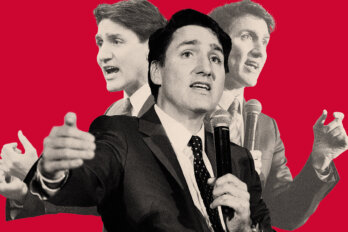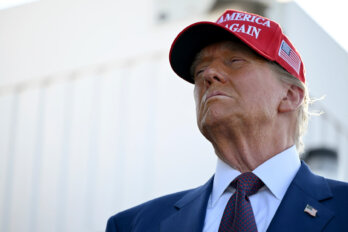Weaving through the throngs of people last year at the Women’s March in Washington, I was poked in the eye by a participant dressed as the Statue of Liberty. She sported a do-it-yourself crown made of sharp sticks. I’d already been caught off guard earlier by a little girl wearing a sandwich board—on one side it read “It’s my pussy!” while the other side showed a fist plunging out from between a woman’s legs extending into an enormously out-of-scale middle finger. Other placards read, “Keep your hands off my pussy!!!” and “This pussy has claws,” the words wrapped around the image of a hissing cat. A woman passed me dressed as a hot-pink vulva.
“Pussy is all over the place!” My friend’s thirteen-year-old daughter giggled, slightly shocked. Truly. But then, he started it.
Many have counted the Women’s March on Washington as the first in a series of political actions that have lead us to our current moment. Speakers that day urged citizens to join organizations, to make donations to social programs, to take up politics locally. That’s exactly what’s happened in the last year: a show of overwhelming support to ACLU and Planned Parenthood, along with more women than ever before running for office. Activists in the LGBTQ and science communities organized protests in the capital last spring. Heroic mayors of sanctuary cities, beginning with Marty Walsh of Boston, stood up and publicly declared that they will not waste resources or compromise their city’s moral integrity by complying with Trump’s orders to target immigrants, a move perhaps spurred by so many public spectacles of disdain for his leadership. Other actions against Trump’s administration have abounded. But the question of how an entitled chauvinist can brag about molesting women without any real consequences remains a problem for civil society.
But that may change soon too. The Canadian Press recently named the #MeToo movement and the conversation about sexual misconduct as the top story of 2017. Allegations by celebrity silence breakers against Hollywood movie mogul Harvey Weinstein provoked a watershed moment last autumn as people (mostly women) used social media to identify themselves as victims of sexual harassment or sexual assault. Prominent public figures who’d abused their power, some of them pegged as serial predators, fell from social positions like so many lemmings over a cliff, and a big pile of kindling was added to what seems like the eternally burning conversation about what constitutes sexual misconduct. New allegations fan the flames each day.
Moving forward in 2018, what lessons can we take from last year’s marches? Firstly, pussy should be all over the place, metaphorically speaking. What I mean is that we need to talk about sex a lot more in public conversations and stop treating it so preciously if we are going to establish boundaries and practices that work in a healthy way. This year should be like one long Dr. Ruth show. The #MeToo movement is an opportunity to freshly map gender relations and sexuality along a healthier meridian. Already in 2018, Oprah Winfrey and other celebrities have endorsed the Time’s Up movement, an action plan to counter sexual harassment in the workplace. As we move further into this year, we might also think of the march as we acknowledge that some moments in this fight will be more uncomfortable than fun. Figuring out how to properly ask if a person would like this or that while still maintaining an element of surprise without crossing a line can feel like new territory, perhaps, but it is all part of a necessary conversation—and one that won’t always be easy.
As we mark the one-year anniversary of the Women’s March, the largest protest in American history, I wonder whether such a tidal response of testimonials might be connected to the global solidarity and support for women’s rights displayed with last year’s protests staged the world over. I hope that we will engage in the sort of compassionate and rigorous conversation that helped define the Women’s March and that we will do it without wasting time in categorically calling each other good and bad feminists. The Women’s March movement was about a lot of things, but the ubiquitous symbol of the event was a pink, knitted pussy hat, an ironic homage to President Trump’s crude boasts about how easy it is for men like him to randomly grab at lady parts and safely get away with it. And I hope that, as we move forward, we will all become more emboldened, just like the many women who marched last year, a great deal of them protesting for the first time.
Dina Murphy was the first person I met at the Women’s March, and she now seems emblematic of the energetic enthusiasm that has sustained the feminist movement in the past year. Dina entered the hotel lobby and dropped her heavy purse on the floor. She crooked her neck from left to right, stretched one arm across her chest, and shifted on her feet like an athlete warming up before a game. It had been a long day’s drive for this grandmother from Nashville. “I’ve never done anything like this before! Half my children love it. The other half thinks I’m crazy!”
I told Dina I hoped the weekend would prove worthwhile. She answered with a low, intimidating drawl. “I want to tell Donald Trump ‘Oh, hell no.’ And when a Southern woman says that, you best run.”
Dina had dramatically raised her eyebrows and nodded with respect when I told her we were seven Canadian women, one of us only a kid. The long road trip south with my friends had provided time to discuss why, as Canadians, we were attending the march: the chauvinism and anti-intellectualism of the presidential campaign; its promises of walls and registries; its descriptions of abortion as shameful, bloody, and occult; its homophobia and racism; its pseudo-populism; its vulgarity. We wanted to resist the new order.
We’d left early that morning from Montreal feeling nervous. There’d been reports on the CBC of cars turned away at the border, signifying that change was already underway with the new regime. We could not have forecast how much worse things would get, that only a few days later, Trump’s administration would impose a travel ban on certain people and countries, along with a list of savage funding cuts to programs across the entire progressive agenda that would unfold like an endlessly long, cartoonish scroll.
I remember reading updates on my phone about the inauguration-day protests: shop windows smashed, clashes with police. Tweets announced that the new regime was scrubbing web pages from the official government site. The page for civil rights was replaced with “Standing Up for Our Law Enforcement Community.” “Climate Change” morphed into the “America First Energy Plan.” The LGBTQ page disappeared. On the radio, we listened as Trump officially became president. I imagined using his speech in my English class to demonstrate how certain lexical sets establish mood; in this case, the bleak words were chosen to construct the nightmarish landscape from which Big Daddy Trump would rescue Americans: tombstones, carnage, disrepair, decay, soldiers, bleed, depletion, ripped, rusted, sad.
After more than thirteen hours of driving and intense conversations about consent and intersectional feminism, we arrived in Washington to an atmosphere of goodwill and a collective purpose: to boldly throw back some drinks. Perched on stools at the hotel bar, women nodded and winked as newcomers gathered around tables, raising glasses of Chardonnay in solidarity. The inauguration played on a big screen that was graciously muted. Trump and Pence danced stiffly with their wives in a way that reminded me of The Lawrence Welk Show, a popular viewing choice on the geriatric ward when I was a candy striper over twenty-five years ago. We jeered and taunted and ordered more wine. It had been a long day. And it would go on to be a long year.
The morning of the march, we left the hotel at 8:30 a.m. to make the 10 a.m. rally. Tributaries of people with pink hats and signs streamed from north, south, east, and west, all flowing into the busy subway station. A winding line of protestors waited to buy passes at the only ticket machine in operation. This was precisely why I’ve always avoided protests: I hate standing around in lines; I hate crowds; I hate group chants. But there was no room for self-oriented whining. Old people with canes were waiting patiently, smiling. Parents had babies strapped to their backs. As we approached the ticket machine, we noticed a helpful local woman with no apparent connection to the march’s organization. She punched the buttons and assisted people with their payments in order to move things along. It was this sort of patience and community-mindedness that defined the day.
There were constant delays, because the whole system was so overloaded with bodies. The muffled voice of the train operator continually promised we’d be moving soon. Normally, people would groan and roll their eyes at such a holdup, but instead people talked and connected with each other. My seatmate was new to DC. She was married to a military man who’d just been stationed there from San Diego. We were stalled long enough for her to tell me she’d moved to America as a Bosnian refugee when she was thirteen, and she told me about the difficulties of that experience. She was marching for the huddled masses that would be denied the same opportunities she’d enjoyed. A grey-bearded Vietnam War veteran carried his wife’s purse and massaged her shoulder. Three young teenagers with pink, orange, and purple hair and jean jackets covered in buttons huddled attentively around an old lady who slowed down her knitting to give them a lesson. She was almost finished creating a pink pussy hat.
“It’s called a stockinette stitch.”
Todd, who works at the Smithsonian, helped by giving the best directions for arriving at the march’s designated meeting point. When it was his turn to leave the subway car, everyone shouted in unison, “Bye, Todd!” There were moments when the train was simply too full for any new passengers, but those left behind on the platform hooted and hollered, waving as the train made its way down the track. It was like taking the subway in Dr. Seuss’s Whoville, but all the Whos are jacked up on ecstasy and, impossibly, more loving.
Hours later, we finally emerged from the subway into daylight. I was divided between reading signs—“I know signs. I make the best signs. They’re terrific. Everyone agrees,” “We Shall Overcomb,” “Nyet My President”—and checking that everyone in our group was together. Other people moved through the crowds forming chains and holding hands so as not to get separated. Eventually we made our way to a spot where we could hear, but not see, the speakers. It was good enough. There were no corporate sponsors, no distracting branding or ads. Everywhere you turned, as far as the eye could see, were people, and it was like that the whole day: nothing on the horizon but more protestors hoisting bright signs, little pink heads like so many cherry blossoms against the bleak, grey sky.
We’d arrived in time to hear Michael Moore incite low booing in response to Trump taking power, after which he provided a to-do list of ways to become more involved in politics. After fifteen minutes, Ashley Judd surprised him by commandeering the stage to perform a poem written by nineteen-year-old Nina Donavon from Tennessee. With the gravel of a country road in her voice and the theatrical inflections of an old-time Baptist revivalist, she declared, “I am a nasty woman!” referring to Trump’s denigration of Hillary Clinton during the presidential debates. One by one, speakers took the stage. In a particularly poignant moment, the singer Janelle Monáe spoke the names of African Americans who have been killed by the police. Mothers of slain boys and men stood on stage beside her, shouting their children’s names—all that was left of their babies—into the microphone. It was an evocatively haunting performance that felt almost like a ritual—half a million voices calling on the dead.
Finally, we marched. We marched to the drumbeats of Indigenous women who prompted us to remember our mothers and our grandmothers. We marched in solidarity, and we marched against hate.
We marched past the no-frills signs of the Christian fundamentalists that were all fear and no flare. Protesters circled them, dancing and chanting, “Love trumps hate, love trumps hate!” Looking back, the scene provided a tableau vivant of the polarized disunity that has come to define American politics over the last year. One sign featured an acrostic poem that spelled the word GAY and read “Got AIDS Yet?” Another read “AIDS: Judgment or Cure?” Anti-abortion signs abounded. An impish girl with long blond hair danced up to a man with a stoic expression on his face and wiggled her butt. She playfully covered his sign with hers: in bubblegum pink glitter, it read, “Say No to Sex with Pro-Lifers.”
“We’re doing this because we love you,” he said. “And we don’t want you to burn in hell.”
The highest sign read, “ATTENTION REBELLIOUS JEZEBELS. Who Could Find a Virtuous Woman?”
“What’s a Jezebel?” asked our thirteen-year-old.
It wasn’t so amusing when she asked why some signs featured coat hangers.
We marched on as the sky darkened, down Independence Avenue, Constitution Avenue, Seventeenth Street. We chanted things that you wouldn’t hear in a folksy Woody Guthrie song. “Hands too small! Can’t build a wall!” “We don’t want your tiny hands anywhere near our underpants!” “We need a leader, not a tweeter!” The thick collection of signs lifted to the sky served as portents. In every direction, there he was: Trump, Trump, Trump. The savage wit of other posters belied a deep fear and disdain of what his presidency would promise at the same time as it served as a wake-up call to civic action, collaboration and organization. Placards warning, “History is watching you” and “We cannot go back” were an augury of this too. I looked up and saw a giant poster of Princess Leia, not in the sexy gold string-bikini and chains imposed by Jabba the Hutt, but in her fighting clothes, looking tough. The slogan read, “Women Belong in the Resistance.”
A very young woman with short violet hair had intrepidly climbed a tree. From its branches, she yelled at passersby, “Tell me what the future looks like?”





